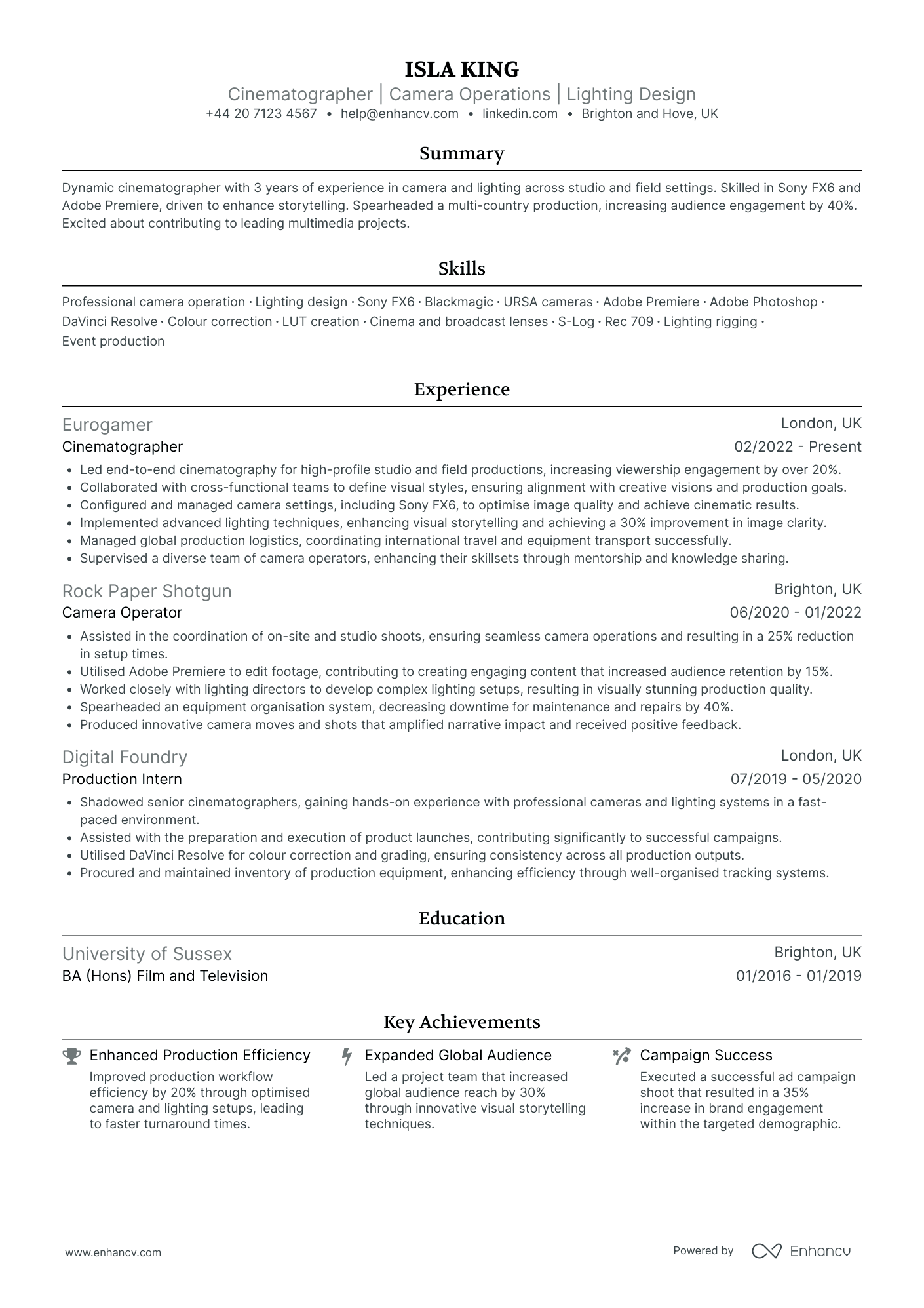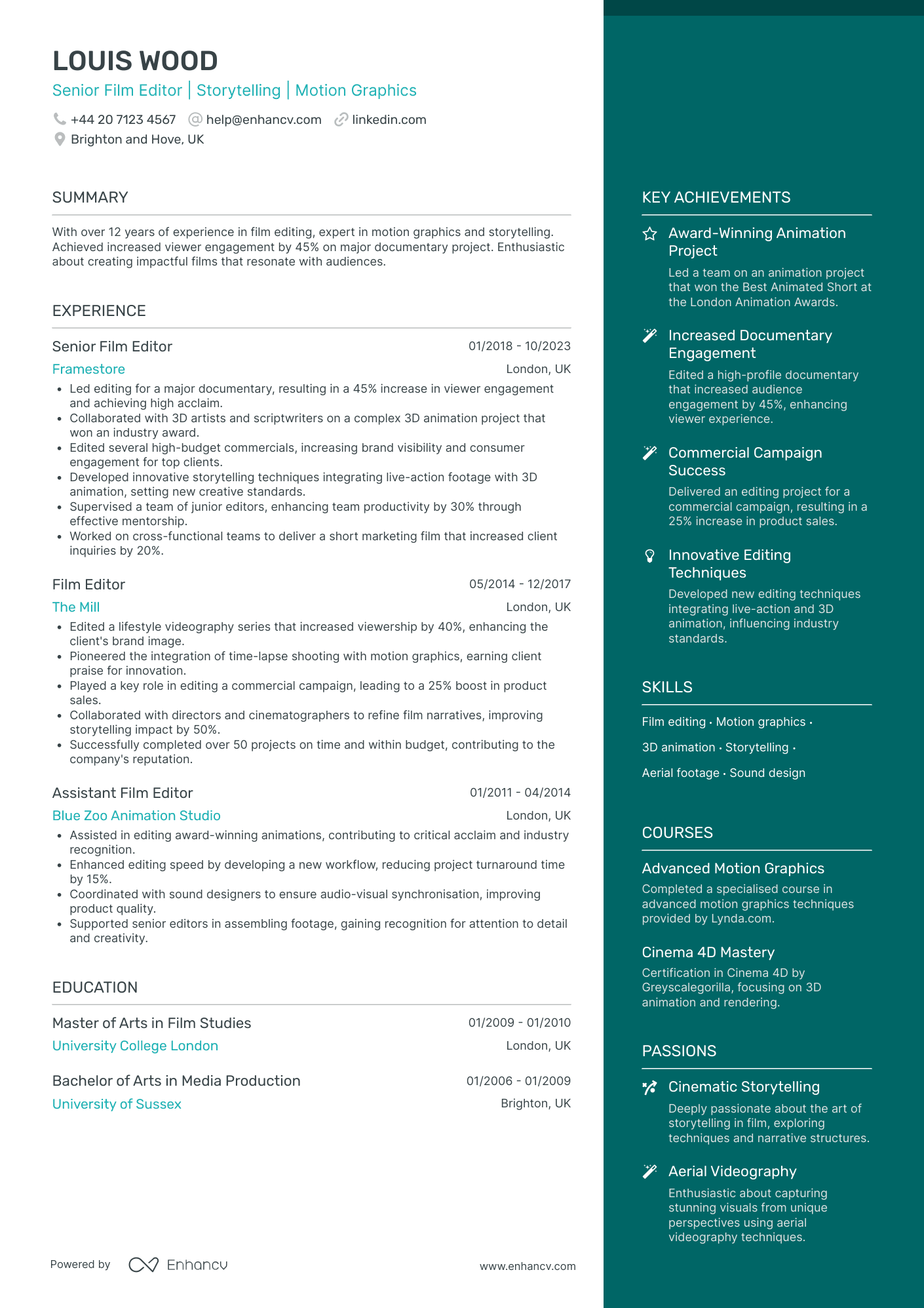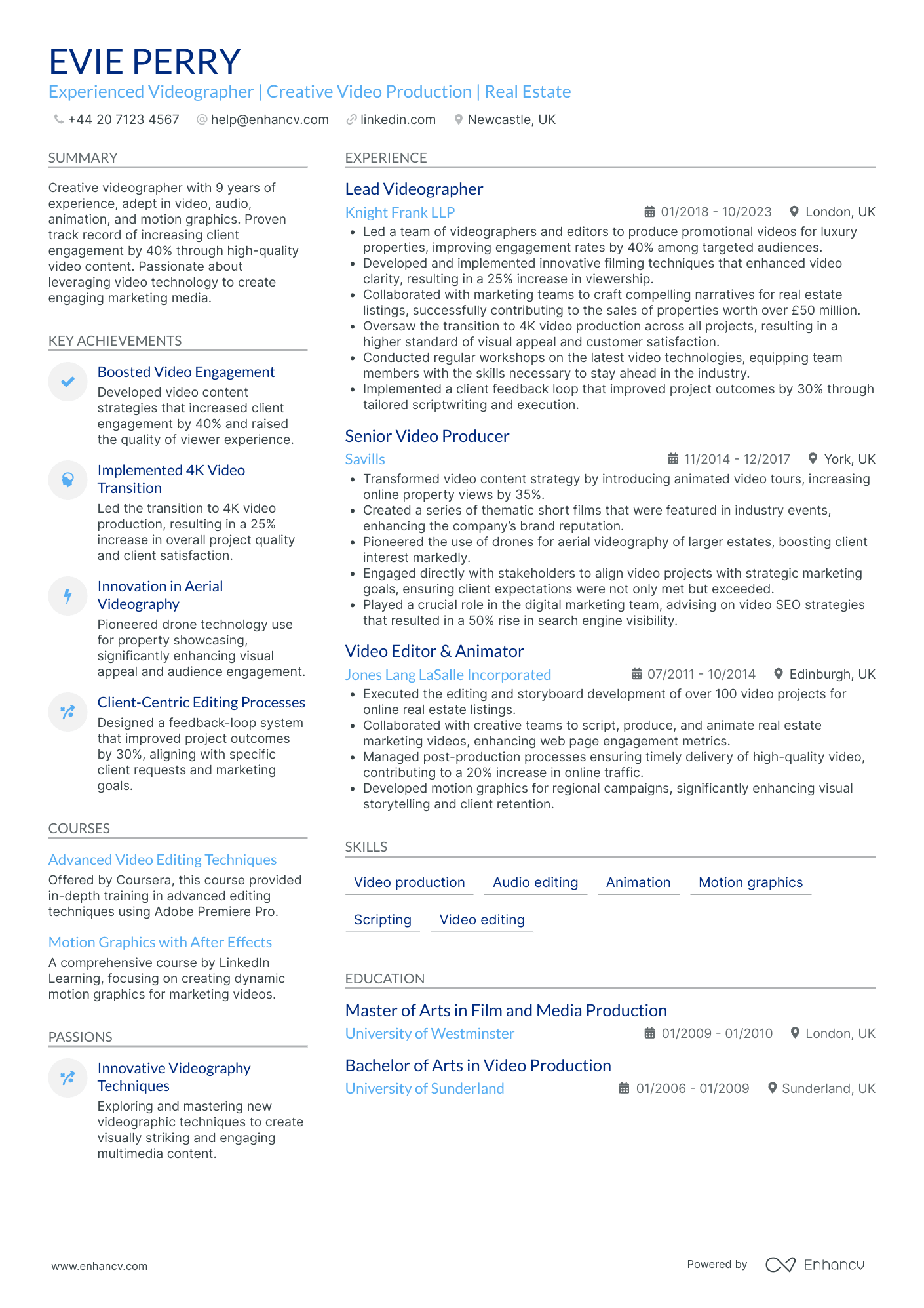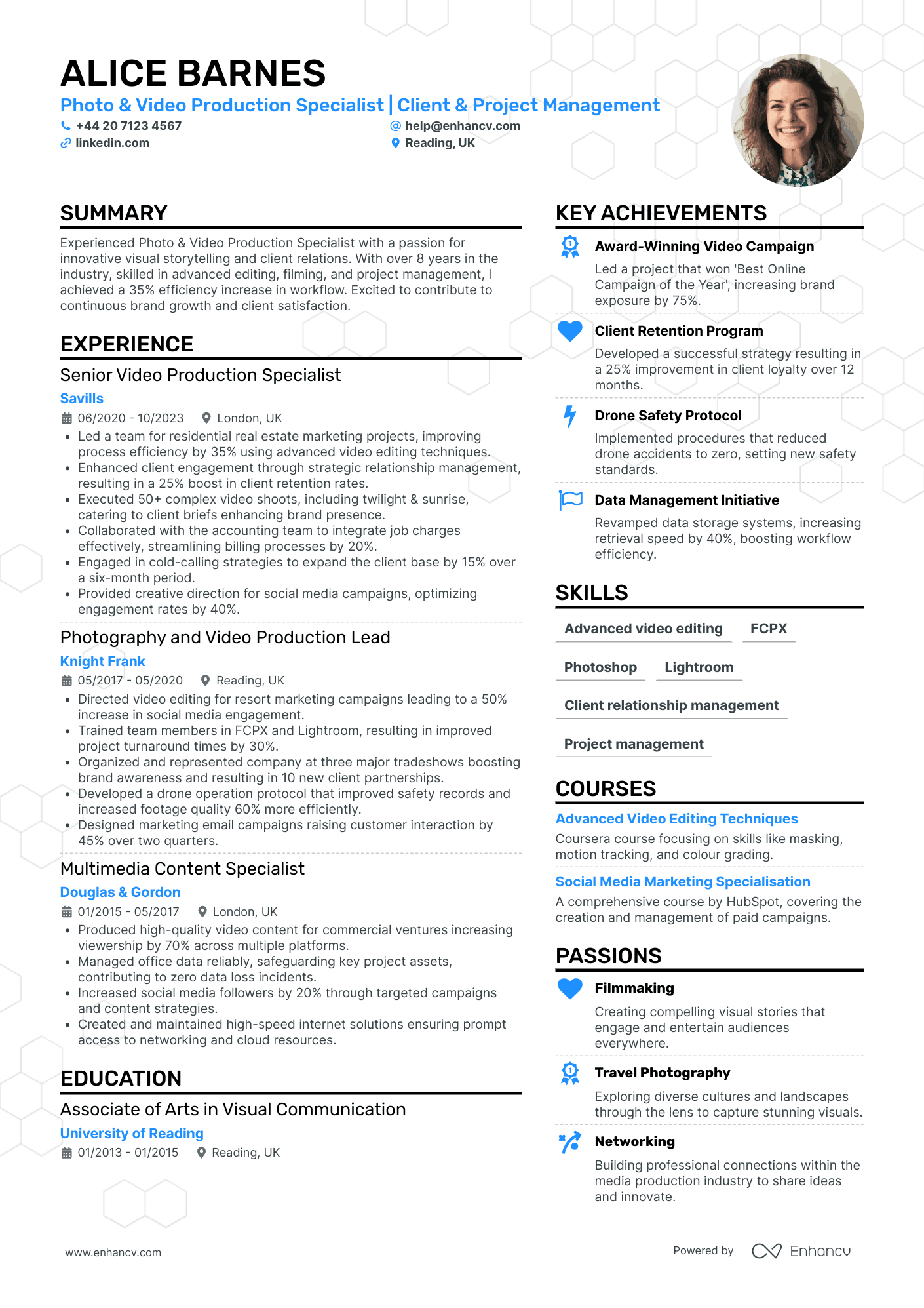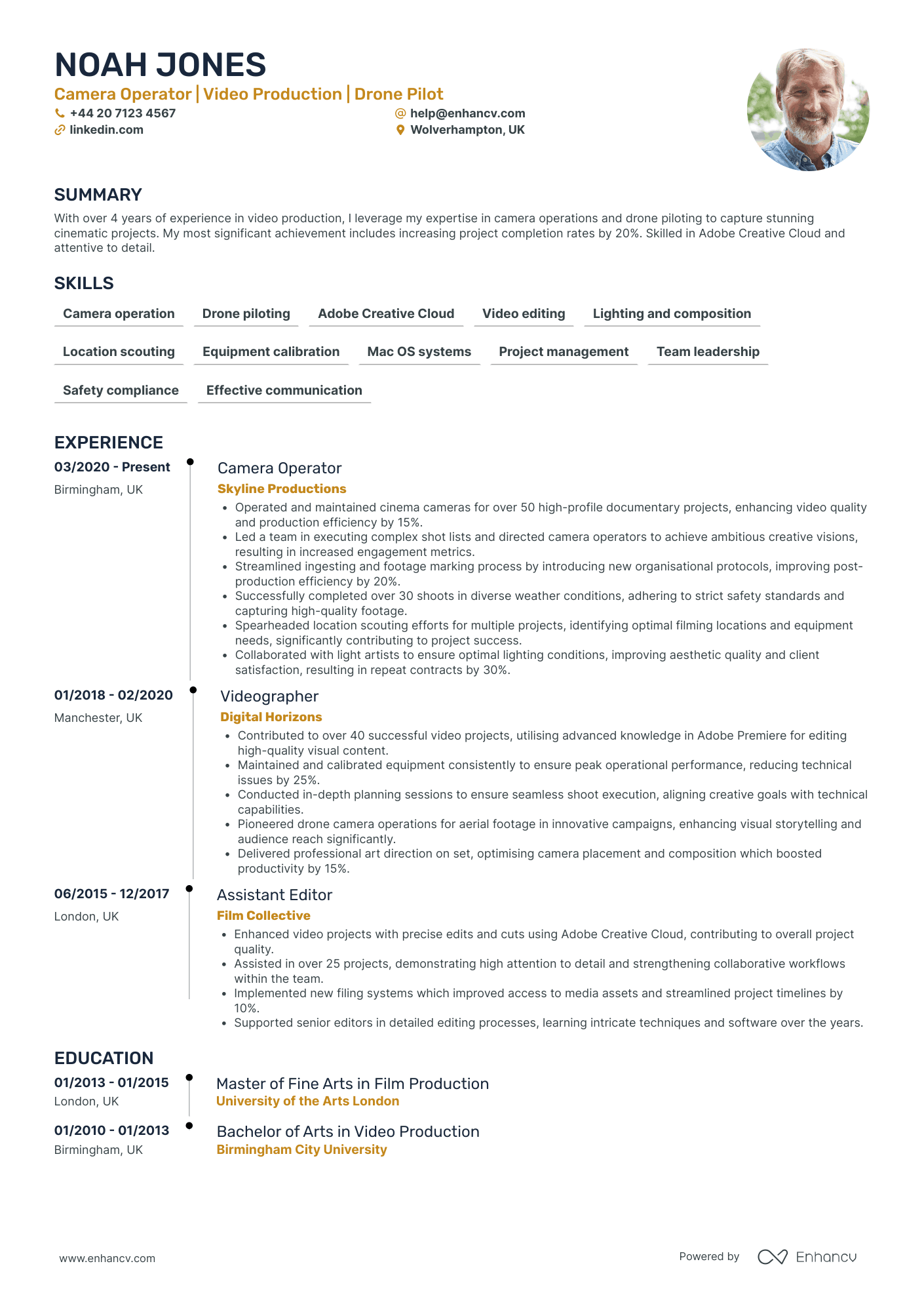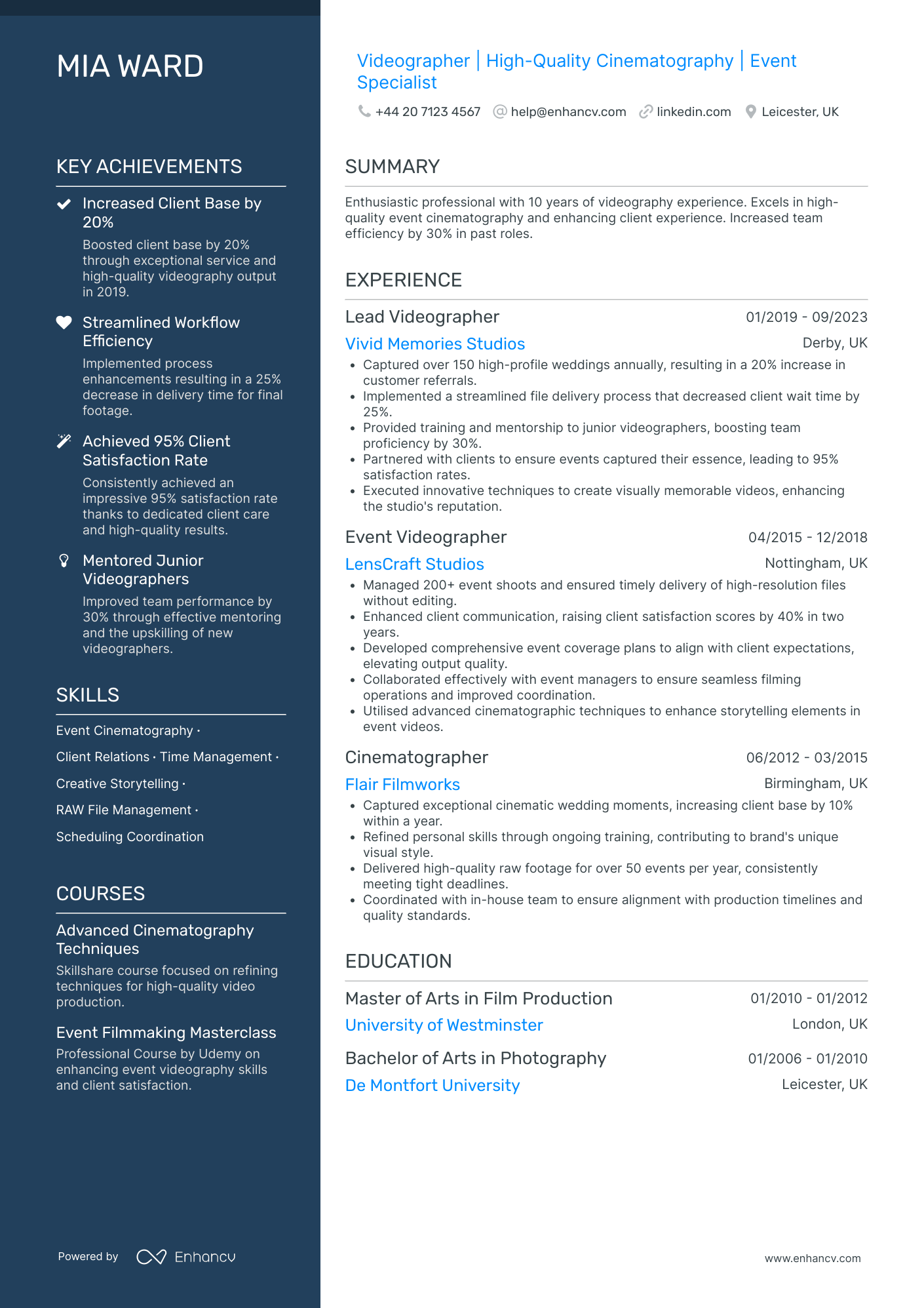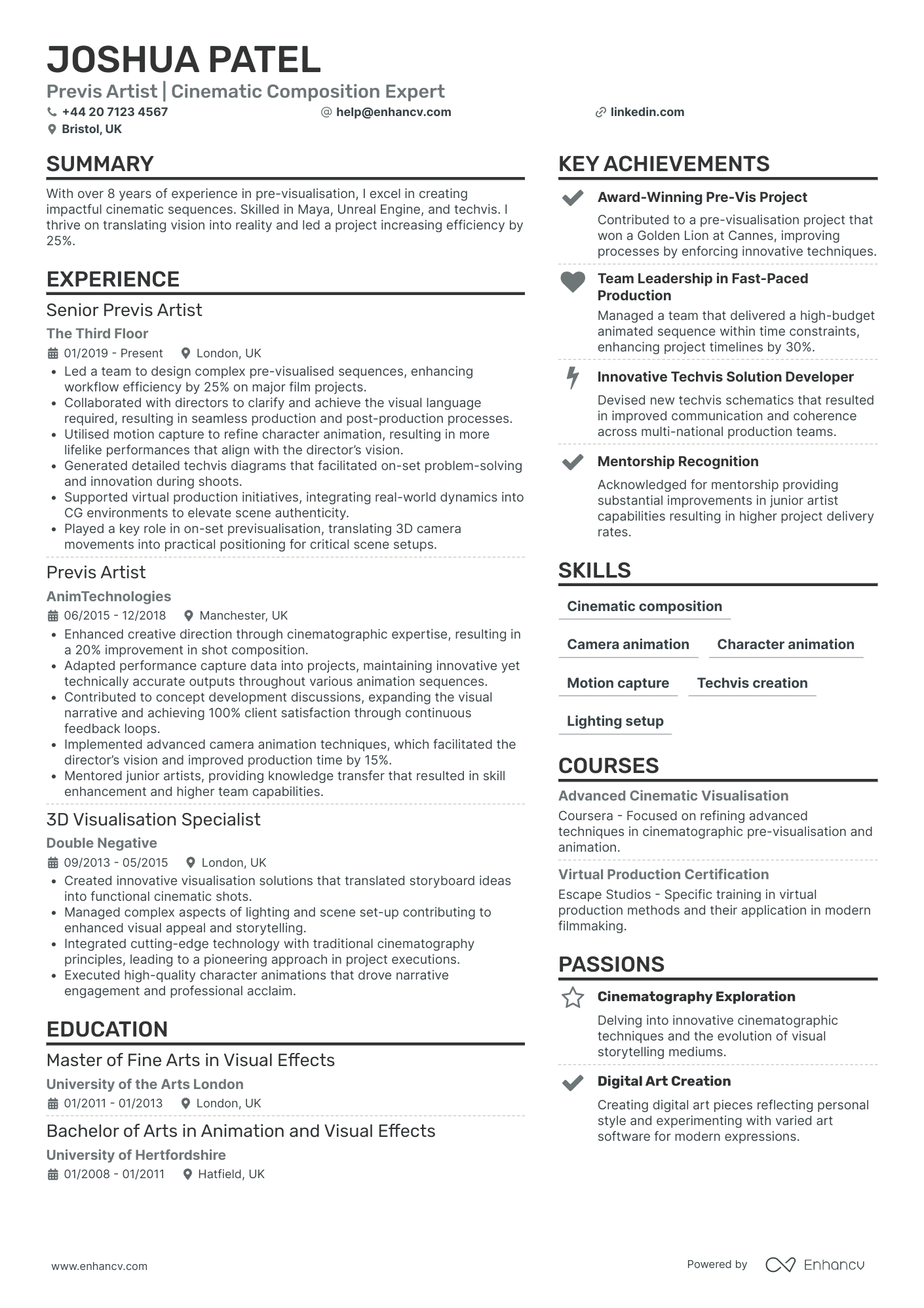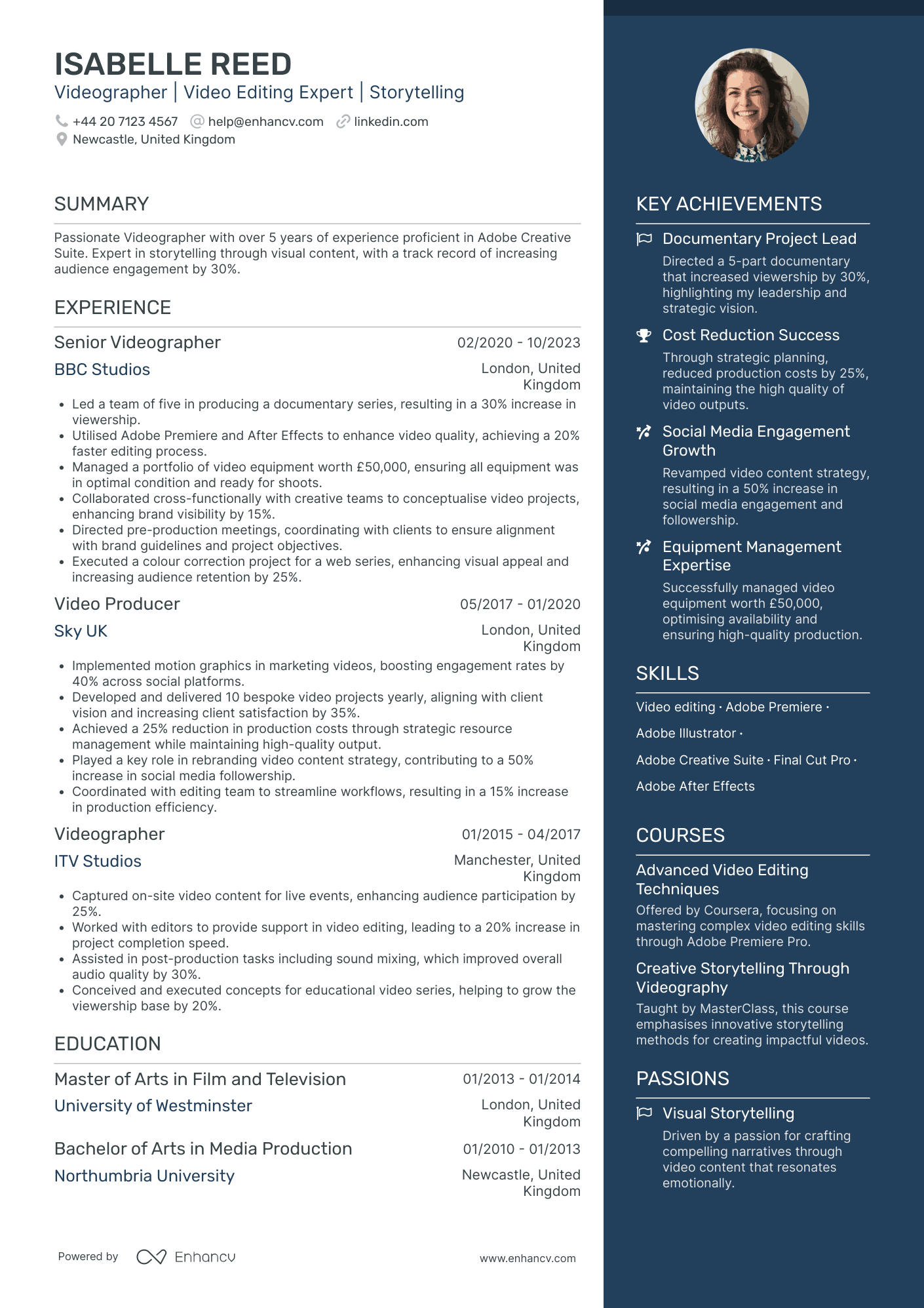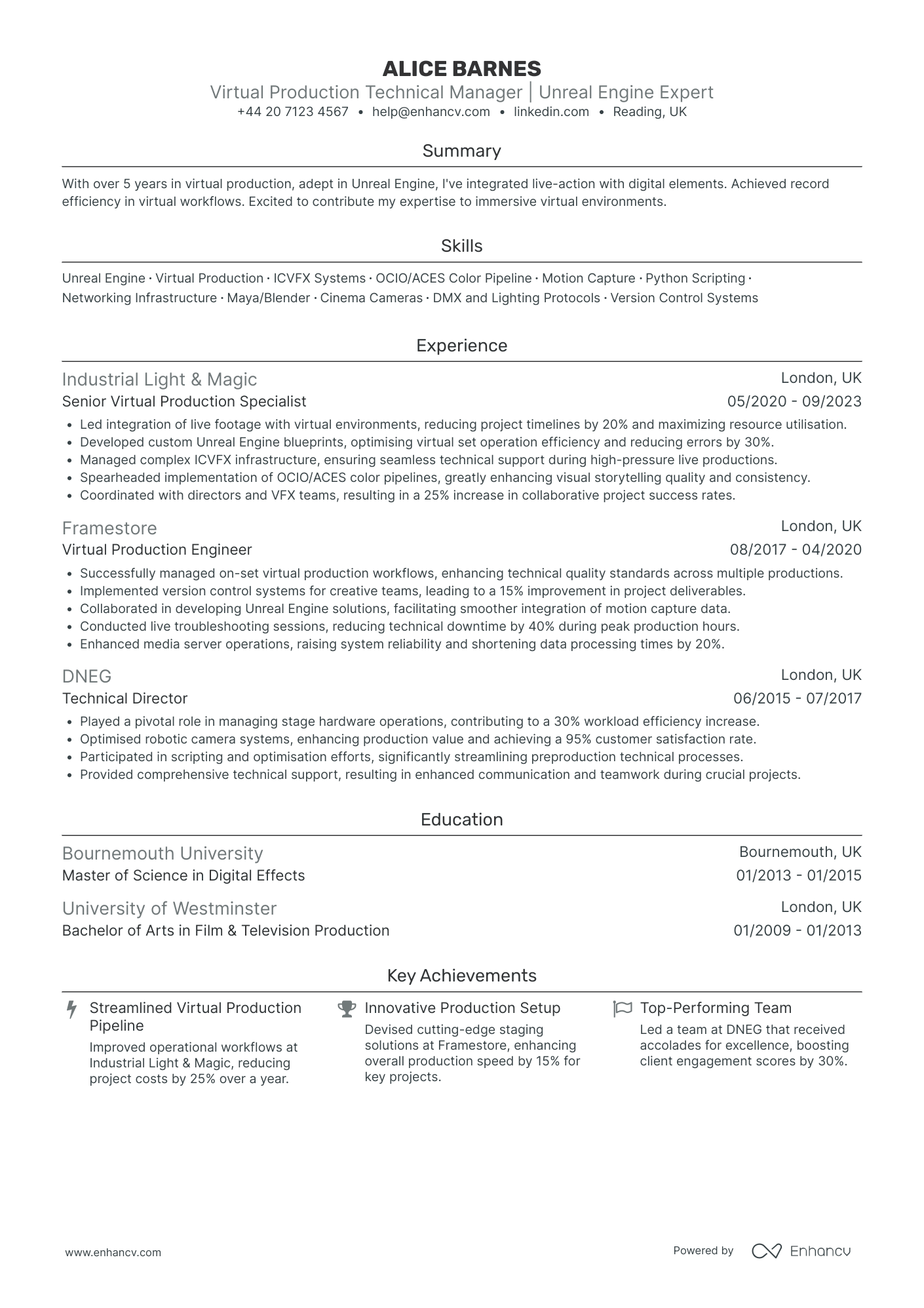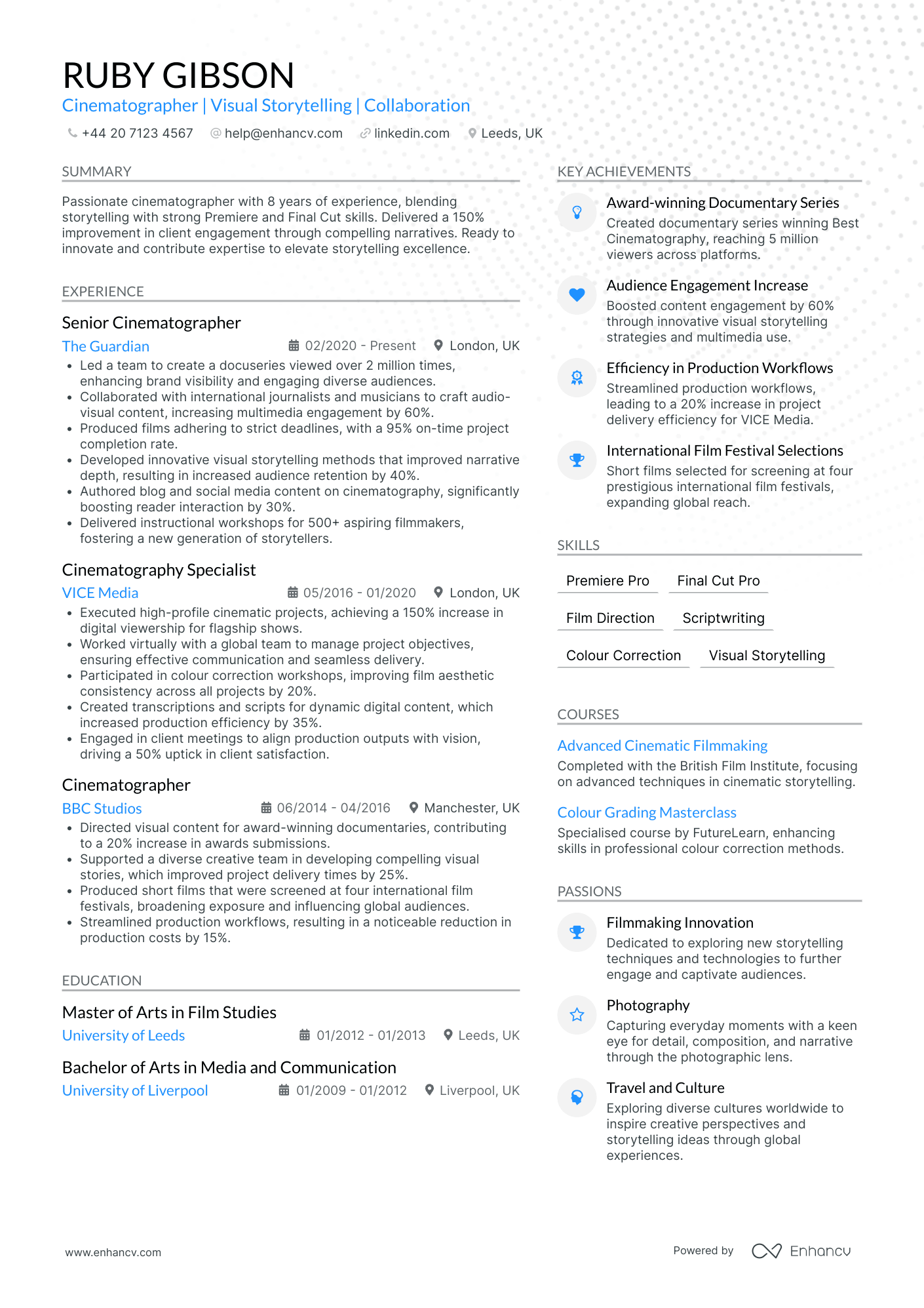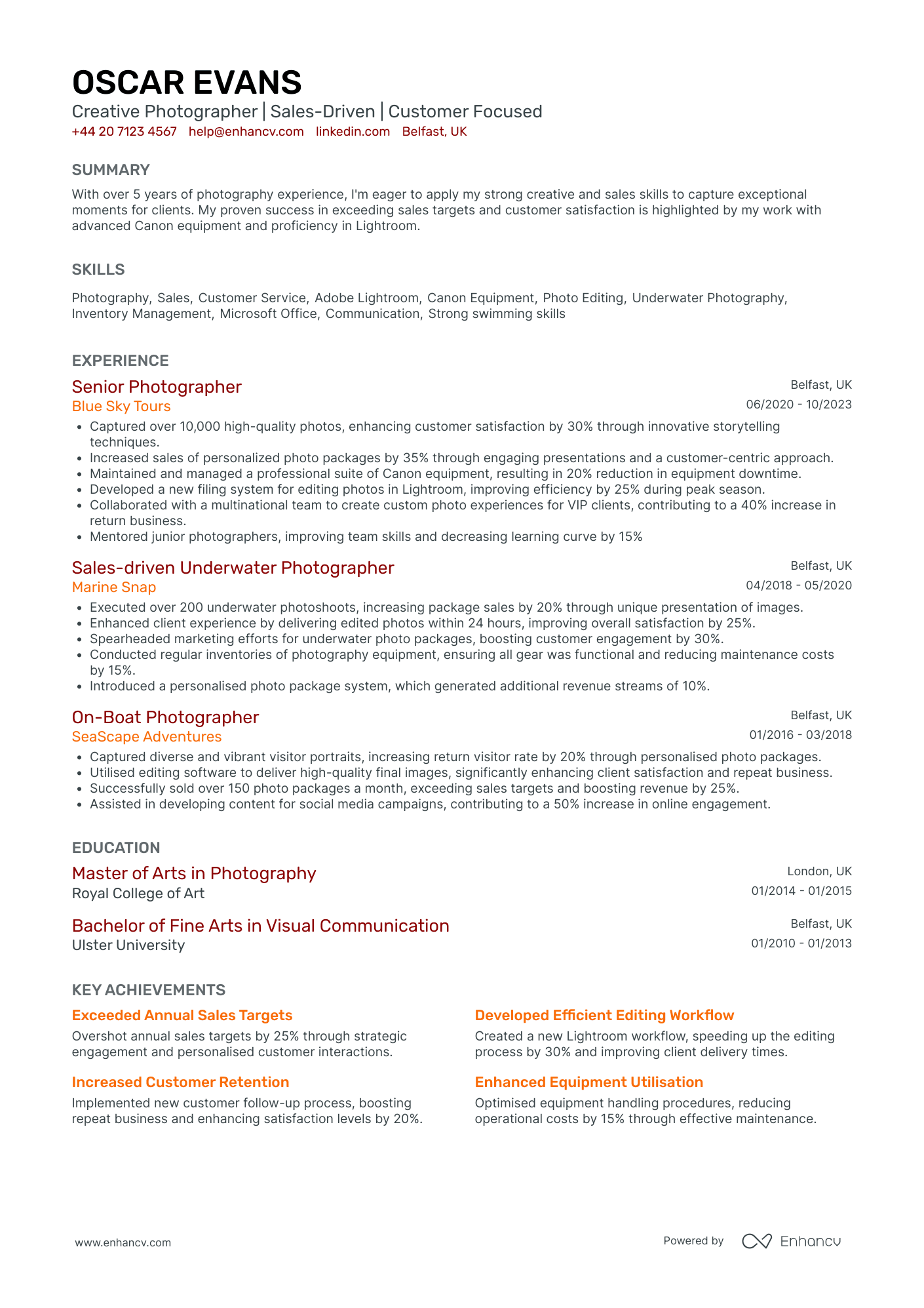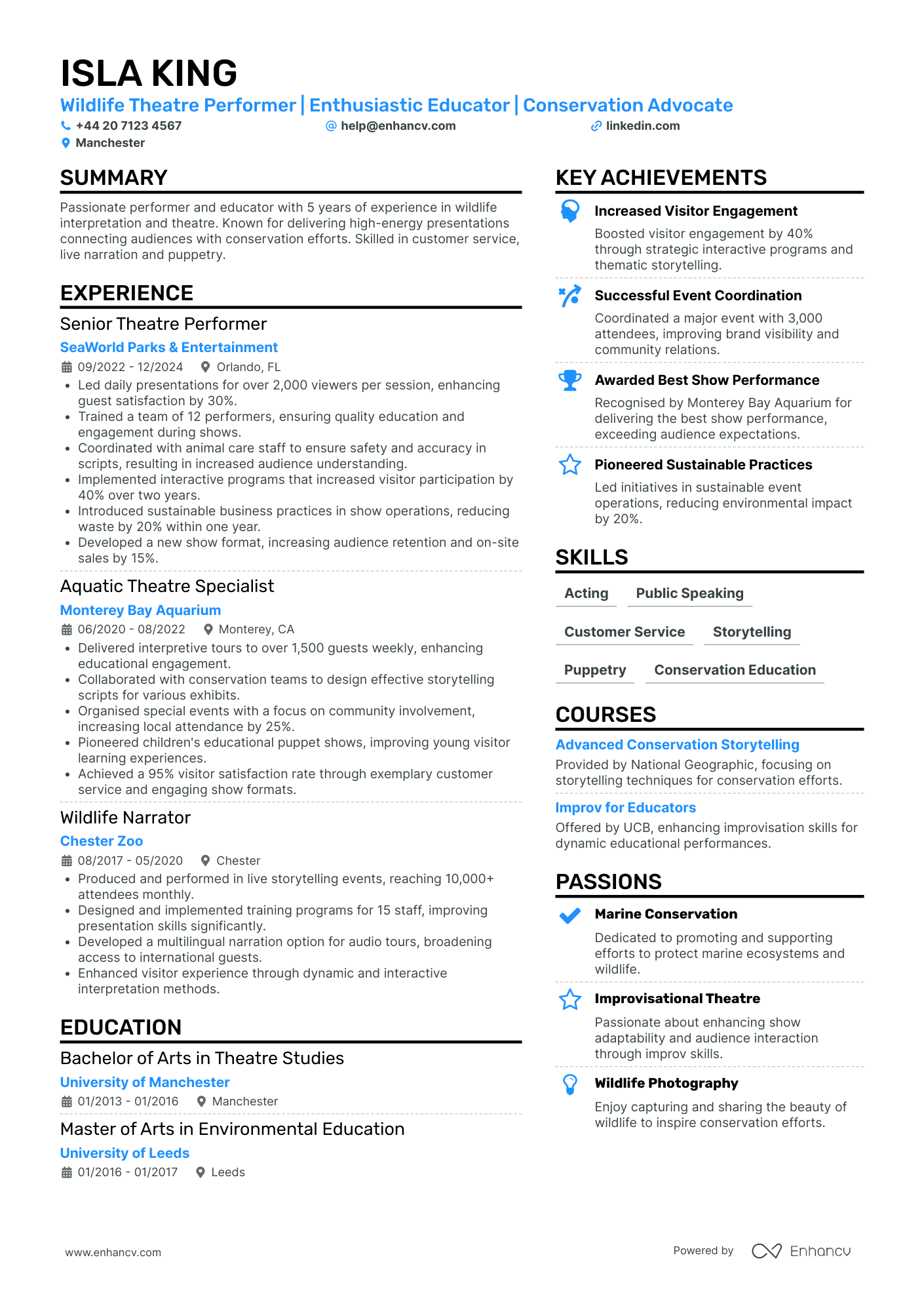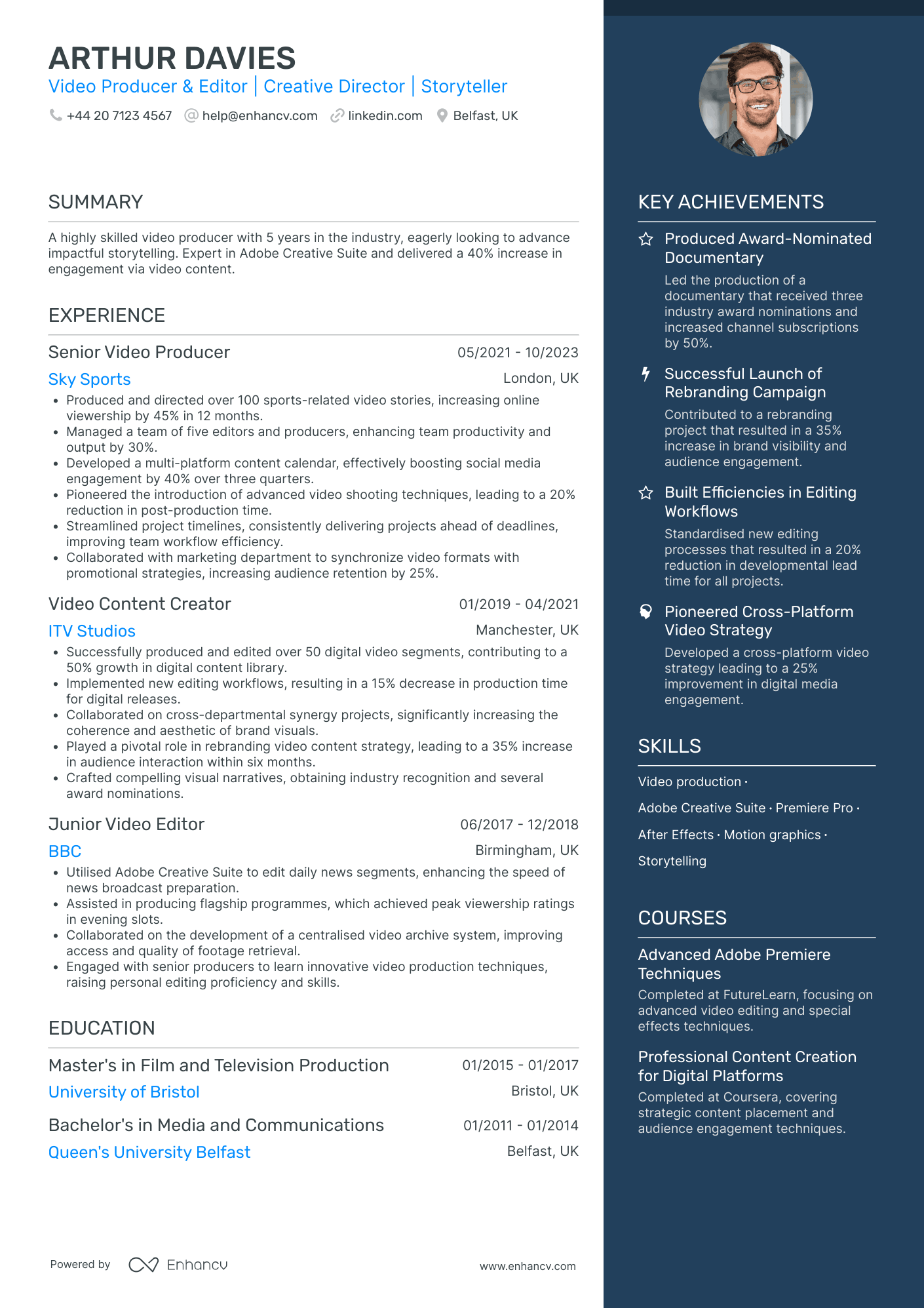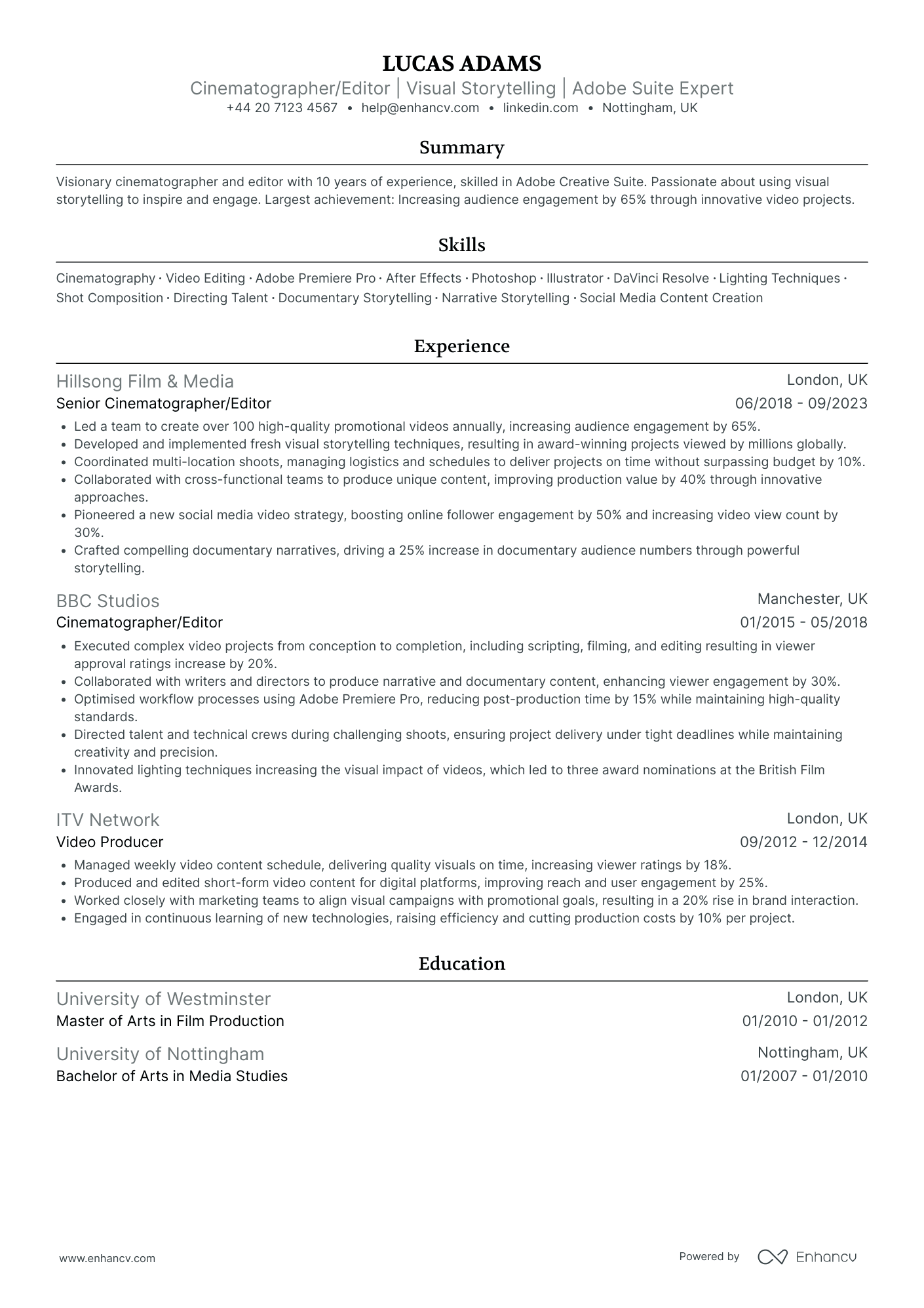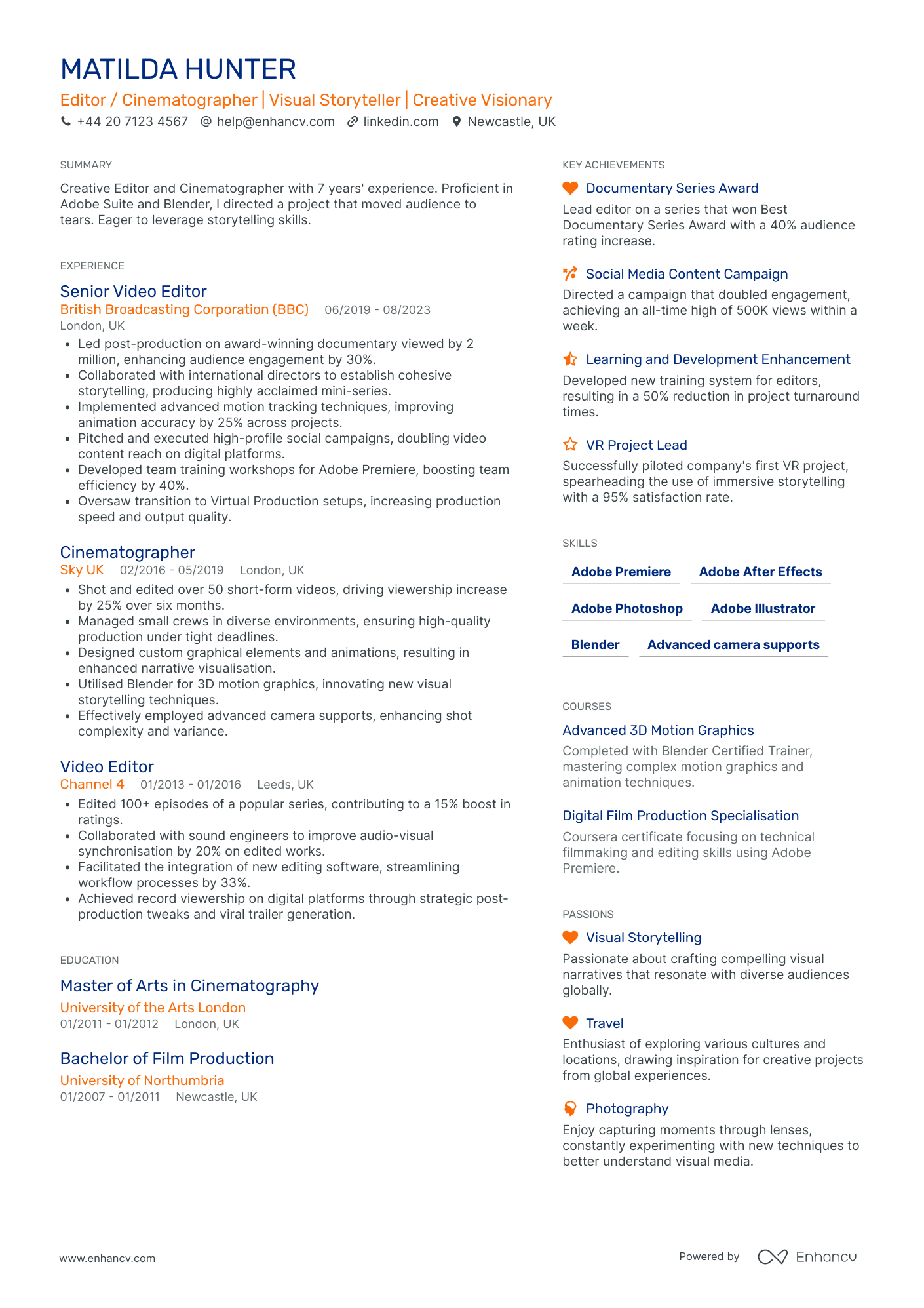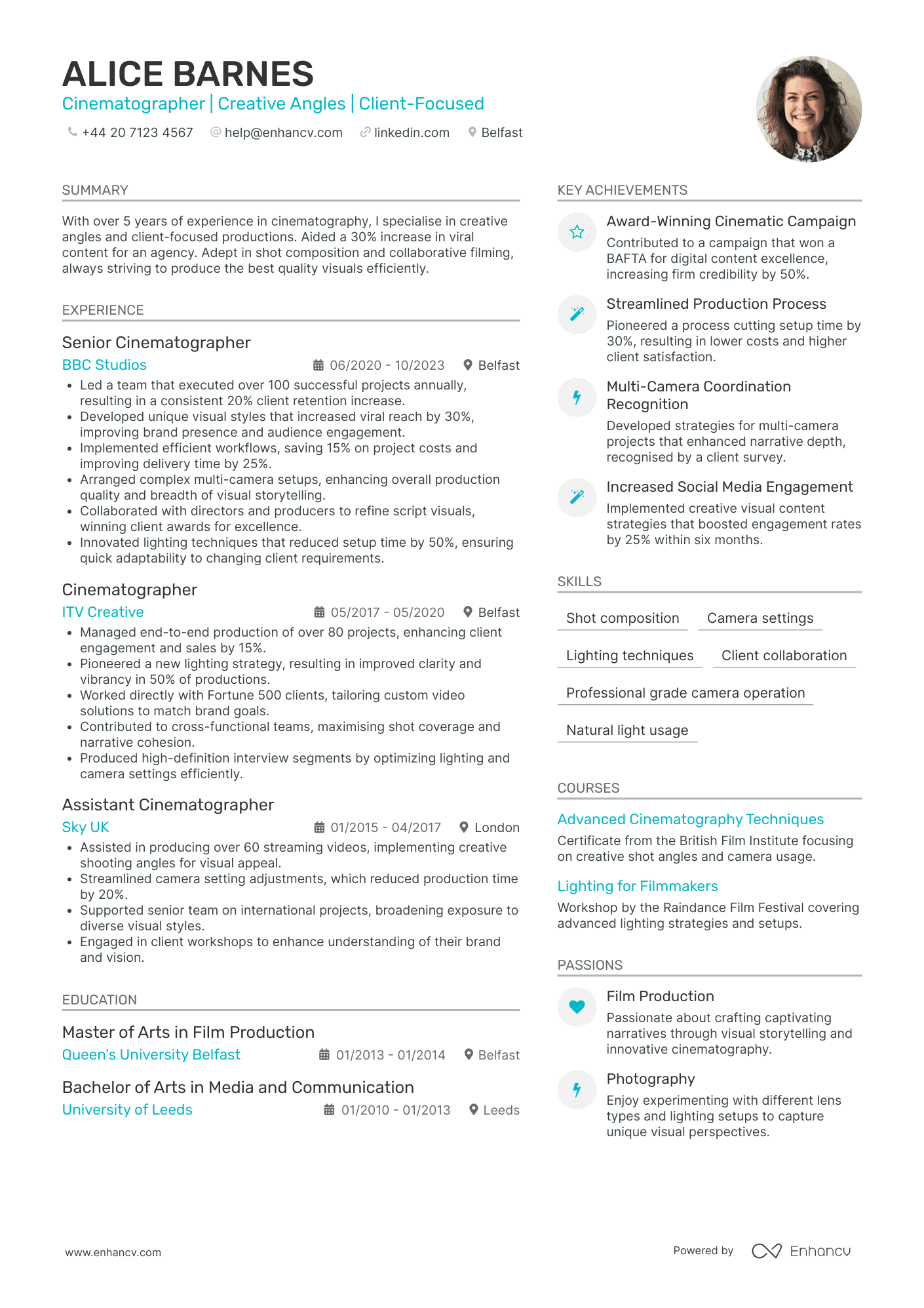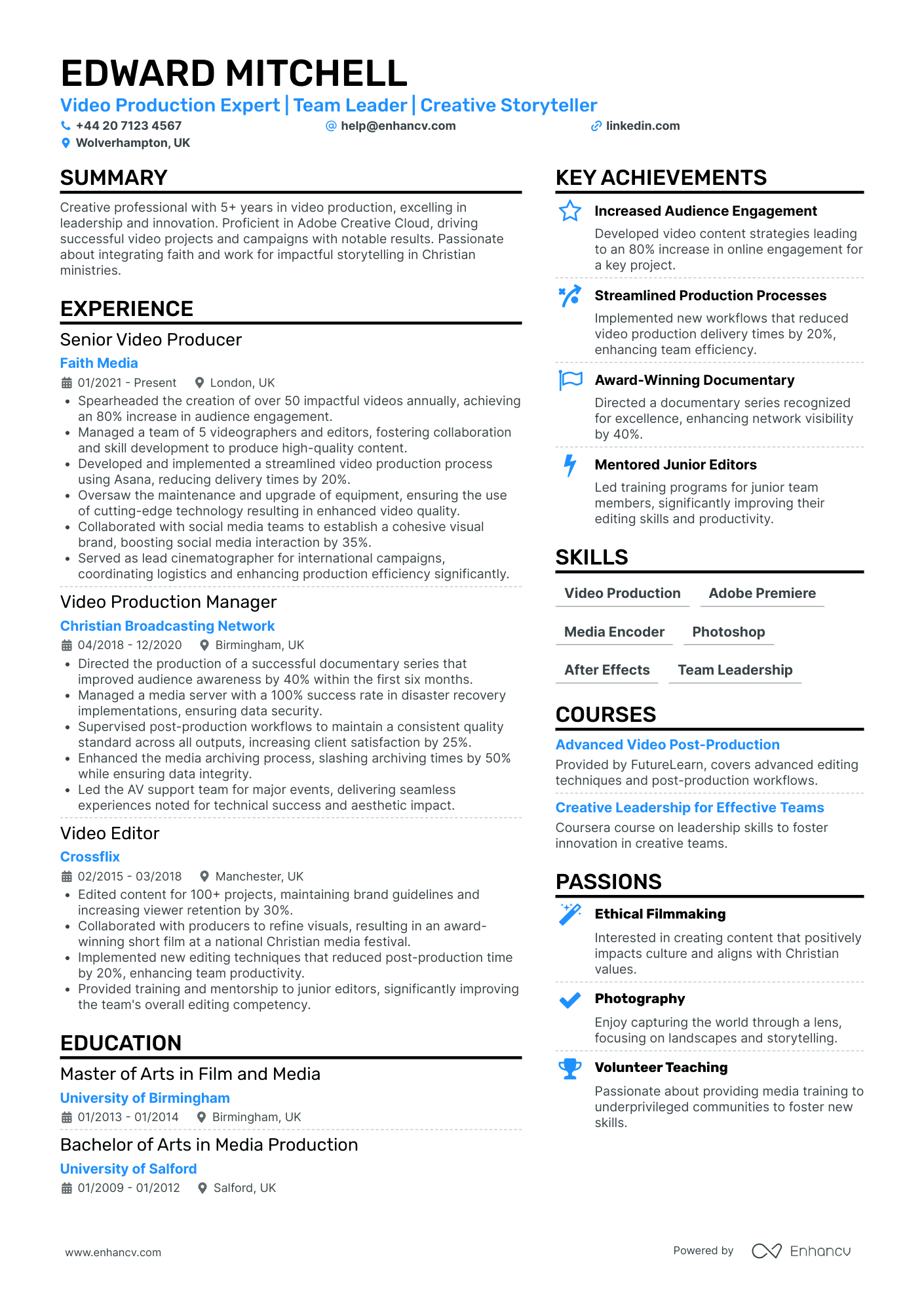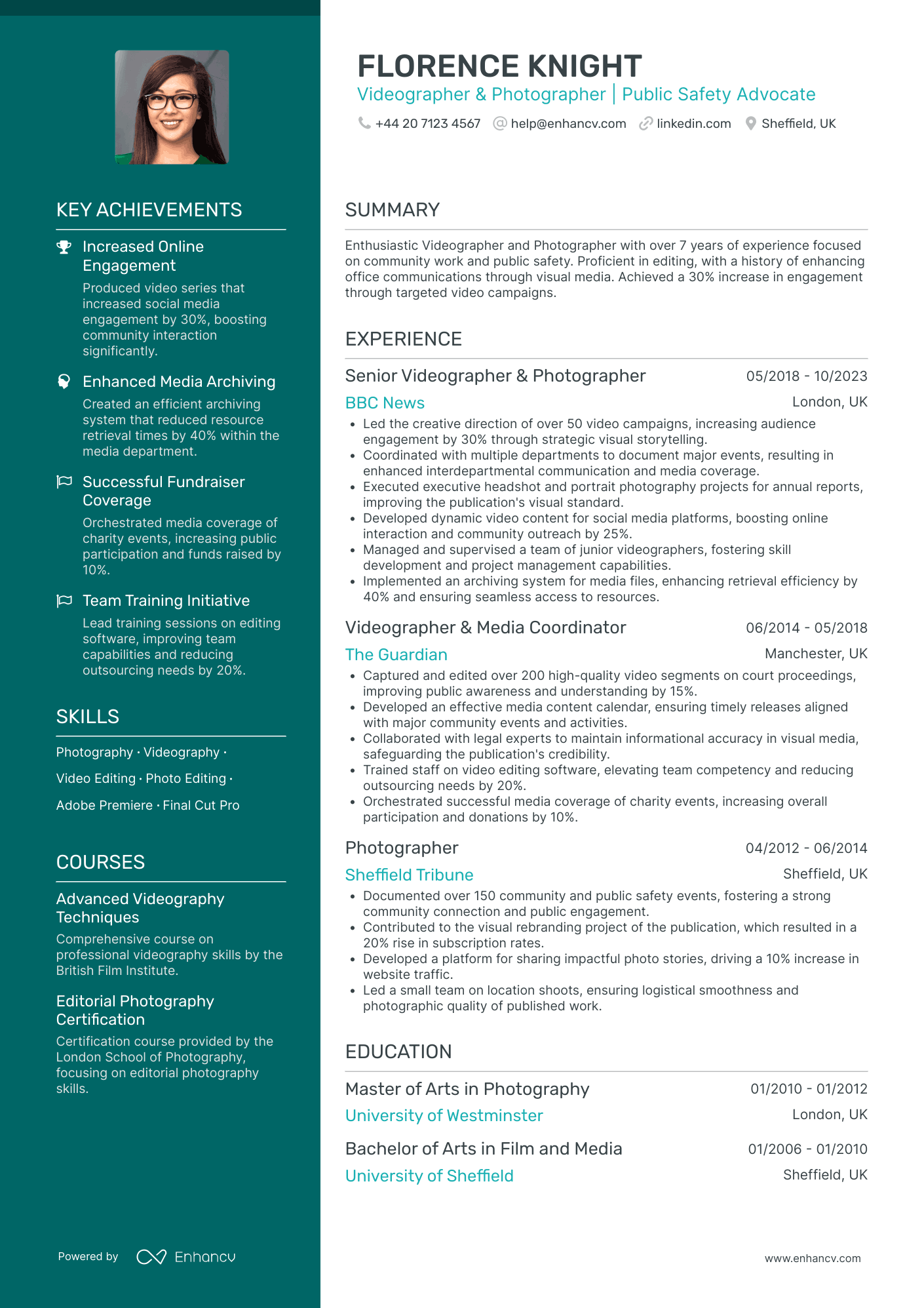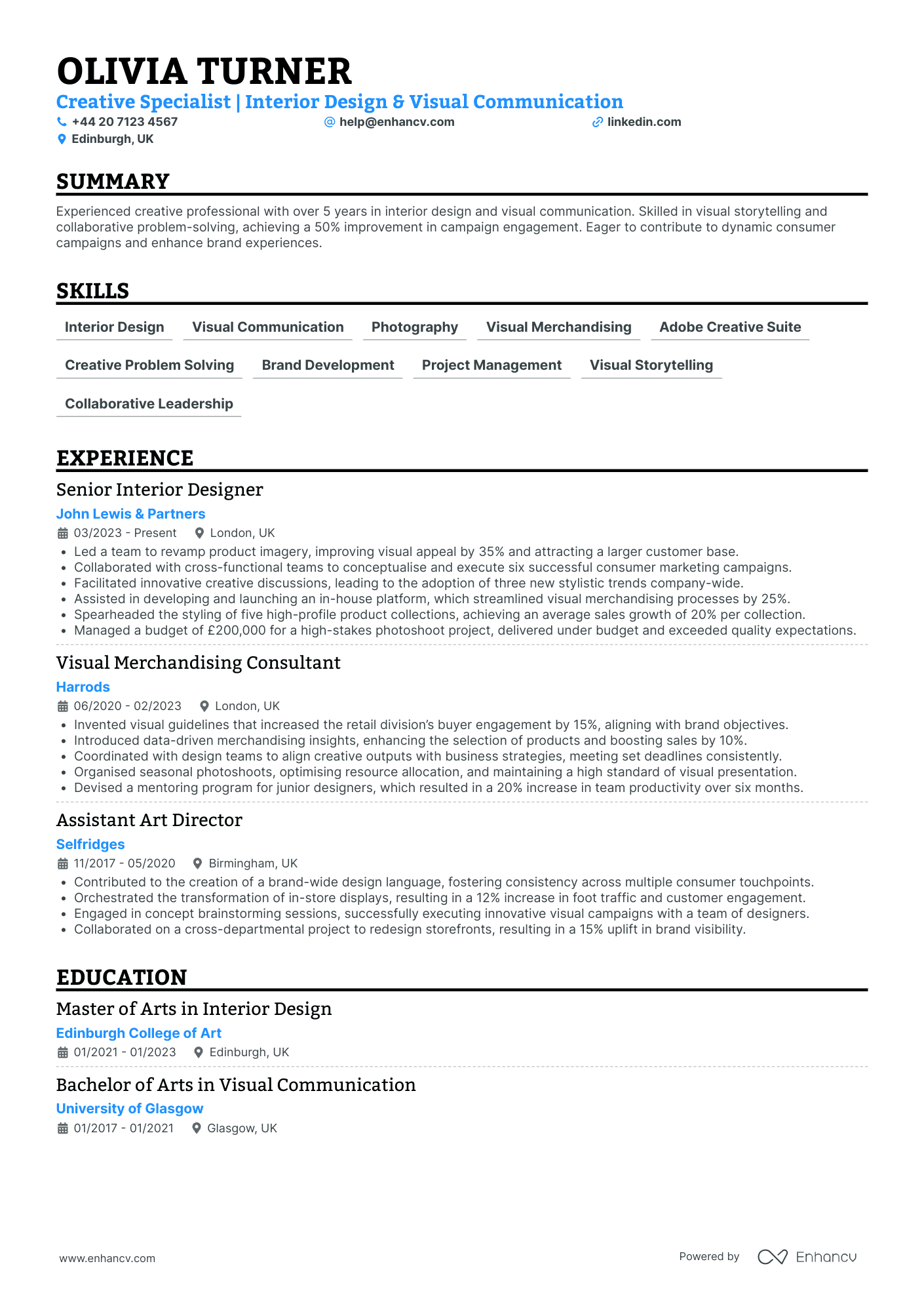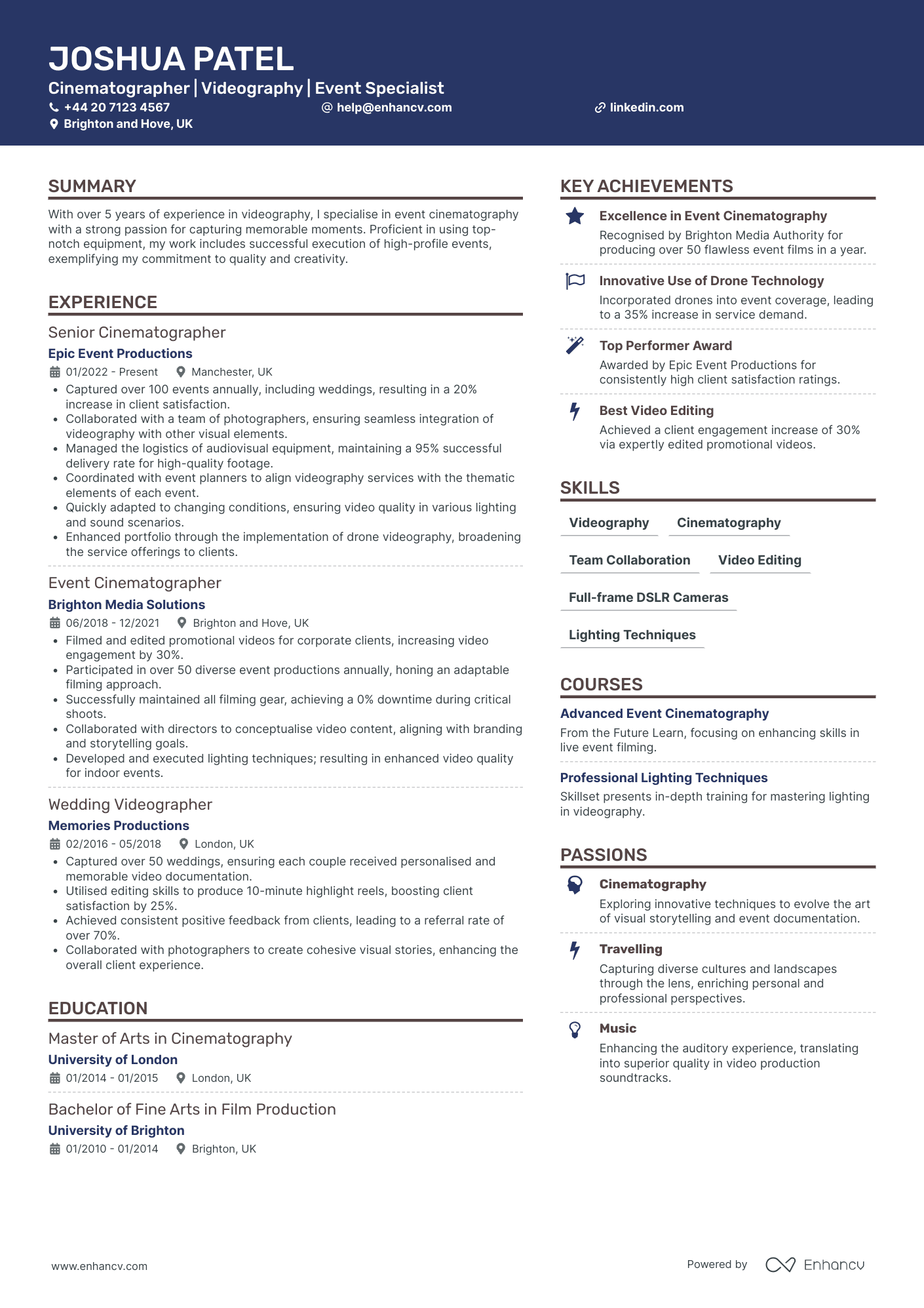One specific CV challenge faced by cinematographers is achieving accurate colour grading under varying light conditions. Our guide can assist by providing you with detailed techniques and tools to maintain consistent hues and tones in your footage, regardless of the shooting environment.
- Applying best practices from real-world examples to ensure your profile always meets recruiters' expectations;
- What to include in your work experience section, apart from your past roles and responsibilities?
- Why are both hard and soft skills important for your application?
- How do you need to format your CV to pass the Applicant Tracker Software (ATS) assessment?
If you're writing your CV for a niche cinematographer role, make sure to get some inspiration from professionals:
Resume examples for cinematographer
By Experience
Junior Cinematographer
- Comprehensive Content Presentation - The CV is structurally clear and concise, providing a seamless flow from one section to another. Each part, from experience to skills and achievements, is well-organized, allowing readers to quickly grasp the key aspects of Isla King's professional journey. The bullet points ensure readability and highlight essential information without overwhelming the reader with excessive detail.
- Strategic Career Growth - Isla King's career trajectory showcases a progressive and strategic climb in the cinematography field. Starting as a Production Intern and advancing to a Cinematographer role within a few years indicates not only growth but also an ability to take on increasing responsibilities. The transitions between companies and roles reflect adaptability and a drive to continually reach new heights within the industry.
- Industry-Relevant Technical Expertise - The CV highlights a deep technical competence with tools specific to the cinematography field, such as Sony FX6 cameras, Adobe Premiere, and DaVinci Resolve. These mentions demonstrate Isla's ability to employ industry-standard technology to produce cinematic results, underscoring her readiness to engage in high-caliber multimedia projects. Her participation in courses and certifications adds to her credibility, showcasing a commitment to staying updated with technological advancements.
Senior Cinematographer
- Clear and Structured Content Presentation - The CV is well-organized, offering a coherent structure that divides information into clearly defined sections such as experience, education, skills, and achievements. Each section is concise, focusing on relevant details that are easy to navigate, which immediately captures the reader's attention and efficiently communicates professional history and expertise.
- Steady Career Growth and Industry Focus - The career trajectory is marked by a clear progression, from Assistant Film Editor to Senior Film Editor, indicating professional growth and increasing responsibility. The focus on well-renowned companies within the film and animation industry highlights a commitment to honing specific technical expertise and leadership within the field.
- Innovative Techniques and Cutting-Edge Tools - Unique industry-specific elements are emphasized through the candidate's use of advanced tools and techniques such as 3D animation, motion graphics, and novel storytelling methods. The integration of live-action footage with 3D animation and the use of software like Adobe Premiere Pro and Cinema 4D demonstrate a high level of technical proficiency and innovation.
Lead Cinematographer
- Structured Career Progression - The CV clearly traces Evie Perry's upward trajectory in the videography field, showcasing a progression from Video Editor & Animator to Lead Videographer. This growth underscores her competence, adaptability, and leadership capabilities across different companies and roles, culminating in substantive responsibilities and achievements at Knight Frank LLP.
- Industry-Specific Expertise - Evie's proficient use of cutting-edge tools and technologies, such as 4K video production and drone videography, set her apart in the real estate videography sector. This technical depth not only enhances her projects' visual quality but also demonstrates her commitment to staying ahead of industry trends, as well as her effectiveness in implementing innovations that boost viewer engagement.
- Emphasis on Measurable Outcomes - The CV highlights Evie's impact through specific achievements, such as a 40% increase in client engagement and a 25% rise in viewership due to improved filming techniques. These figures are presented alongside detailed context, emphasizing her ability to drive significant business results and improve client satisfaction through high-quality video content creation.
By Role
Assistant Cinematographer
- Career Trajectory Demonstrating Progressive Growth - Alice Barnes' CV illustrates a well-defined career growth path within the media production industry. Starting as a Multimedia Content Specialist and advancing to Senior Video Production Specialist, it reflects her ability to scale responsibilities and leadership roles. This progressive growth is a testament to her competence and adaptability, essential for the prospective roles she is pursuing.
- Technical Prowess and Specialized Knowledge - The CV distinctly highlights Alice's proficiency with industry-specific tools and methodologies such as advanced video editing, FCPX, Photoshop, and Lightroom. Her skills in motion tracking, color grading, and drone operation showcase deep technical knowledge, crucial for delivering exceptional multimedia content and enhancing video production quality.
- Achievements with Significant Business Impact - Alice's accomplishments go beyond mere numbers; they exert measurable impact on business outcomes. For instance, her initiative in developing a client retention program led to a 25% improvement in loyalty, and her work on an award-winning video campaign increased brand exposure by 75%. Such achievements underscore her strategic and results-driven approach in media production and client relationship management.
Documentary Cinematographer
- Organized Content Structure - Noah's CV is meticulously structured, beginning with a succinct summary highlighting key skills and experiences relevant to the role. Each section, from experience to education, is clearly delineated, enabling easy navigation and ensuring that critical information is quickly accessible to the reader.
- Demonstrated Career Growth - The CV presents a clear trajectory of professional development from Assistant Editor to Camera Operator, underscoring Noah's ability to take on increasing responsibilities within the video production industry. This progression is indicative of growing expertise and dedication to the craft, enriching his profile with experience from diverse roles.
- Technical Proficiency with Industry Tools - Noah's proficiency in industry-standard tools such as Adobe Creative Cloud and drone piloting stands out, showcasing his capability to handle complex technical demands within video production. His completion of both a Masterclass in Adobe Premiere Pro and FAA Drone Pilot Certification further underscore his commitment to maintaining cutting-edge technical skills.
Feature Film Cinematographer
- Structured and Focused Presentation - The CV is meticulously organized, ensuring each section is clear and purposeful. The structured format aids readability, allowing each career milestone and educational achievement to be swiftly identified without clutter or ambiguity.
- Dynamic Career Progression - Mia Ward's career trajectory demonstrates significant advancement from a Cinematographer to a Lead Videographer. This progression reflects not only a deepening expertise in videography but also an increasing leadership role, indicating professional growth and industry recognition.
- Achievements with Tangible Impact - The CV features specific achievements that link directly to business impact, such as a 20% increase in customer referrals and a 25% decrease in client wait times through workflow optimization. These metrics showcase Mia's ability to drive significant operational and client satisfaction improvements.
Television Show Cinematographer
- Exceptional Clarity and Structure - The CV presents a well-organized structure, maintaining clarity and brevity across all sections. It efficiently summarises extensive experience and skills with concise descriptions, making it easy for recruiters to identify key qualifications and achievements that pertain directly to the role of a Previs Artist.
- Impressive Career Progression - Joshua's trajectory from a 3D Visualisation Specialist to a Senior Previs Artist reflects a clear pattern of growth within the industry. Each role has been strategically placed, showcasing enhanced responsibilities and leadership skills over time, affirming his dedication and capability to adapt and excel in complex environments.
- Industry-Specific Technical Expertise - The CV stands out with its inclusion of industry-specific tools and methodologies, such as Autodesk Maya, Unreal Engine, and motion capture techniques, underscoring the candidate's profound technical depth. This emphasis not only highlights his expertise but also his ability to deliver precise and sophisticated visual solutions crucial to cinematic compositions.
Music Video Cinematographer
- Structured and Cohesive Presentation - The CV is meticulously organized, presenting information in a logical flow from professional summary to experience, education, and skills, ensuring clarity and ease of navigation. Each section concisely encapsulates relevant details, allowing for quick comprehension of the candidate's qualifications and expertise.
- Progressive Career Advancement - The career trajectory depicted in the CV demonstrates significant professional growth. Isabelle has progressively advanced from a Videographer at ITV Studios to a Senior Videographer at BBC Studios, reflecting her continuous development in expertise and responsibility within the media industry.
- Industry-Specific Technical Proficiency - The CV highlights Isabelle’s adeptness with specialized tools such as Adobe Creative Suite and Final Cut Pro, emphasizing her technical depth. Her accomplishments in utilizing software for video enhancement and project management underscore her expertise in employing industry-standard methodologies.
Commercial Cinematographer
- Structured and Clear Presentation - The CV features a polished and logical structure, with clearly defined sections for Experience, Education, Skills, Courses, and Achievements, ensuring that each aspect of the candidate’s professional profile is easy to navigate and understand. The concise bullet points in the experience section effectively summarize complex responsibilities and achievements, allowing for quick comprehension.
- Demonstrates Impressive Career Growth - Alice Barnes’ career trajectory shows significant growth and advancement within the virtual production industry. She progressed from a Technical Director to a Senior Virtual Production Specialist, evidencing her expertise and increasing responsibilities. Her transitions reflect a harmonious blend of technical proficiency and strategic leadership, vital for her current role as a Technical Manager.
- Outstanding Technical Expertise in Industry-Specific Tools - Alice’s CV emphasizes her deep knowledge and experience with industry-standard tools crucial for virtual production environments. Her proficiency in Unreal Engine, OCIO/ACES color pipelines, and ICVFX systems demonstrates a robust technical foundation essential for leading high-stakes virtual production projects.
Aerial Cinematographer
- Clear Progression and Growth - The CV effectively showcases Ruby Gibson's career trajectory with clear progress into senior roles. Starting from a Cinematographer at BBC Studios and advancing to a Senior Cinematographer at The Guardian, this path highlights a steady ascent driven by skills and consistent results in the field of visual storytelling and cinematography.
- In-depth Industry Knowledge and Technical Expertise - Ruby's CV underlines extensive knowledge of industry-specific tools like Premiere Pro, Final Cut Pro, and methodologies including colour correction and advanced cinematic filmmaking. Such technical depth exemplifies her capacity to drive significant improvements in content engagement and production processes, making her a valuable asset to any media production team.
- Leadership and Mentorship - Ruby distinguishes herself as a leader through her experience leading a team at The Guardian and engaging in instructional workshops. These efforts not only exhibit her ability to manage and mentor aspiring filmmakers but also demonstrate her commitment to fostering new talent and contributing to the filmmaking community's growth and innovation.
Underwater Cinematographer
- Clarity and Structured Content Presentation - The CV is well-structured and clearly presents the candidate’s experiences, skills, and achievements. Each section is distinctly labeled, allowing for easy navigation and assimilation of information, necessary in capturing a potential employer's attention quickly.
- Strategic Career Development - The career trajectory shows a clear path of growth from an On-Boat Photographer to a Senior Photographer, highlighting significant promotions and enhanced responsibilities. This progression exemplifies Oscar's upward mobility within the photography industry, showcasing an increasing impact and greater leadership roles over time.
- Distinctive Industry Expertise - The CV stands out by showcasing unique skills such as underwater photography, advanced Lightroom techniques, and handling professional-grade Canon equipment. These niche proficiencies not only underscore technical depth but also emphasize specialized capabilities that differentiate the candidate in the competitive field of photography.
Wildlife Cinematographer
- Career trajectory illustrates consistent growth - Isla King’s career path highlights steady advancements in her field, with significant promotions from a Wildlife Narrator to a Senior Theatre Performer. Each role builds upon the last, showcasing increasing responsibilities and leadership in educational and performance settings.
- Soft skills and leadership through effective team management - The CV underscores Isla's adeptness in training and leading teams, illustrated by her experience in training staff at SeaWorld Parks & Entertainment and Chester Zoo. These experiences demonstrate her capability to enhance team performance and ensure high-quality audience engagements.
- Achievements reveal substantial business impact - The CV does more than list accomplishments by tying them to tangible business outcomes. For instance, introducing a new show format at SeaWorld not only increased audience retention but also boosted on-site sales by 15%, demonstrating her ability to fuse creativity with business acumen.
Sports Cinematographer
- Clear and Strategic Content Organization - The CV is well-structured, with distinct sections such as experience, education, skills, courses, and achievements. This organization makes it easy for readers to quickly grasp Arthur Davies' career journey and qualifications, which is crucial for recruiters who often skim through resumes.
- Demonstrates Significant Career Advancement - Arthur's career trajectory shows a progressive advancement from a Junior Video Editor to a Senior Video Producer within a short span. This progression highlights not only his competence and growth in the video production field but also his ability to take on greater responsibilities.
- Technical Prowess with Industry-Specific Tools - Arthur's proficiency in Adobe Creative Suite, Premiere Pro, and After Effects underscores his technical capabilities and industry relevance. His expertise in advanced video editing techniques reflects a strong foundational knowledge critical for roles in video production and direction.
Drone Cinematographer
- Clear and Compelling Structure - The CV is organized in a user-friendly manner, with well-defined sections such as experience, education, and skills. Each section is concise, yet comprehensive, allowing the reader to easily navigate through the candidate's professional history and expertise.
- Strategic Career Progression - The progression from Video Producer at ITV Network to Senior Cinematographer/Editor at Hillsong Film & Media highlights continuous professional growth, increasing responsibilities, and a refined focus on visual storytelling and audience engagement.
- Technical Mastery of Industry-Standard Tools - Lucas showcases deep expertise with relevant technical tools like Adobe Premiere Pro and DaVinci Resolve, illustrating proficiency that aligns with expectations for high-quality video production and editing roles.
360-Degree Cinematographer
- Structured with an emphasis on storytelling - Matilda's CV is well-organized, presenting information in a clear and concise manner. The structure follows a logical progression from personal details to professional experiences and achievements, making it easy for readers to understand her career path and accomplishments. This clarity enhances her emphasis on storytelling, a key aspect of her role.
- Continuous career progression with industry recognition - Matilda’s career trajectory demonstrates significant growth, progressing from a Video Editor at Channel 4 to a Senior Video Editor at BBC, highlighting her increasing responsibilities. This advancement depicts her capability to adapt and excel, culminating in her leadership in high-profile projects that have earned industry accolades.
- Technical prowess in industry-specific tools - The CV highlights Matilda's proficiency in crucial industry tools such as Adobe Suite and Blender, illustrating her technical depth. Her ability to implement advanced motion tracking and virtual production showcases her innovative approach to enhancing production quality, setting her apart in a competitive field.
Freelance Cinematographer
- Clear progression in the film industry - The CV effectively outlines Alice Barnes’ journey starting from an Assistant Cinematographer to a Senior Cinematographer. It demonstrates a well-structured career path marked by increasing responsibility and expertise, especially notable with her leadership role at BBC Studios. This growth trajectory emphasizes her ability to adapt and thrive in a competitive industry.
- Unique cinematographic techniques and methodologies - Alice showcases an impressive depth of industry-specific skills, including innovative lighting techniques and multi-camera coordination strategies. These technical proficiencies, combined with her ability to develop unique visual styles, position her as a valuable asset capable of enhancing production quality and storytelling depth.
- Significant business impact through achievements - The CV highlights notable contributions such as aiding a 30% increase in viral content and implementing workflows that reduced project costs by 15%. These metrics illustrate not just Alice's skills but also her impact on improving operational efficiency and increasing client satisfaction, making her contributions highly relevant for prospective employers focused on both creativity and business outcomes.
Travel Cinematographer
- Comprehensive and Structured Presentation - The CV is excellently structured, starting with a clear header that encapsulates key personal details, followed by a concise summary that sets the tone. Each section is systematically organized, allowing for easy navigation and quick grasp of the candidate's qualifications and career achievements.
- Progressive Career Growth and Leadership Skills - Edward Mitchell's career trajectory shows impressive growth, from a Video Editor to a Senior Video Producer. His roles illustrate a consistent rise in responsibilities, including team leadership and project spearheading, highlighting his ability to grow within the industry and take on larger, more complex roles over time.
- Integration of Soft Skills with Technical Expertise - The CV demonstrates a balanced combination of technical proficiency in video editing tools like Adobe Creative Cloud with leadership and team management abilities. It highlights his capability to lead teams effectively while implementing technical knowledge in delivering high-quality, innovative video content.
Fashion Cinematographer
- Structured career trajectory - Florence Knight's CV highlights a well-defined career path starting from a Photographer role at Sheffield Tribune to a Senior Videographer & Photographer position at BBC News. This progression showcases her growth within the media and visual content creation industry, reflecting her increasing level of responsibility and expertise over the years.
- Showcases leadership and mentorship skills - Her experience at BBC News includes managing a team of junior videographers, highlighting her capability in leadership and skill development. This leadership aspect is important as it indicates Florence's ability to mentor and influence a team, which would contribute to an organization's long-term growth in media production.
- Highlights technical proficiency and industry-specific methodologies - The CV effectively presents Florence's proficiency with critical tools and software like Adobe Premiere, Final Cut Pro, and Photoshop, which are essential for advanced photography and videography. Additionally, her awards for projects like archiving system improvements, which enhanced resource retrieval efficiency, underscore her ability to implement industry-specific methodologies to gain tangible improvements.
News Cinematographer
- Strategic Career Growth - Olivia's career trajectory illustrates significant growth, moving from an Assistant Art Director to a Senior Interior Designer within prominent UK retail companies. This progression demonstrates her ability to take on more responsibilities and leadership roles, showcasing her advancement and adaptability in the industry.
- Depth in Visual Communication - The CV reveals strong industry-specific expertise, particularly in leveraging advanced visual communication tools and methodologies. Olivia's mastery of the Adobe Creative Suite and her experience with cutting-edge storytelling techniques highlight her technical depth and innovation in the creative field.
- Transformative Achievements - Olivia's accomplishments have a notable business impact, such as increasing campaign engagement by 20% and enhancing brand perception through improved visual standards. These achievements not only present impressive numbers but also underscore her ability to drive strategic outcomes and make a significant mark on brand experiences.
Event Cinematographer
- Clear and Structured Presentation - The CV utilizes a well-organized structure with distinct sections for experience, education, skills, and achievements. This clarity ensures that key information is accessible, allowing potential employers to quickly grasp Joshua Patel's qualifications and career highlights.
- Progressive Career Growth - Joshua's career trajectory shows a clear progression from a Wedding Videographer to a Senior Cinematographer. Each role demonstrates an increase in responsibility and scope, reflecting his growing expertise and leadership within the field of videography and event cinematography.
- Technical Expertise with Modern Tools - The inclusion of specific tools and methodologies, such as drone videography and full-frame DSLR cameras, highlights Joshua’s ability to incorporate advanced technology into his work. This technical depth not only enhances his service offerings but also showcases his commitment to staying at the forefront of industry trends.
Structuring and formatting your cinematographer CV for an excellent first impression
The experts' best advice regarding your CV format is to keep it simple and concise. Recruiters assessing your CV are foremost looking out for candidates who match their ideal job profile. Your white space, borders, and margins. You may still be wondering which format you need to export your CV in. We recommend using the PDF one, as, upon being uploaded, it never alters your information or CV design. Before we move on to the actual content of your cinematographer CV, we'd like to remind you about the Applicant Tracker System (or the ATS). The ATS is a software that is sometimes used to initially assess your profile. Here's what you need to keep in mind about the ATS:
- All serif and sans-serif fonts (e.g. Rubik, Volkhov, Exo 2 etc.) are ATS-friendly;
- Many candidates invest in Arial and Times New Roman, so avoid these fonts if you want your application to stand out;
- Both single and double column CVs can be read by the ATS, so it's entirely up to you to select your CV design.
PRO TIP
Be mindful of white space; too much can make the CV look sparse, too little can make it look cluttered. Strive for a balance that makes the document easy on the eyes.
The top sections on a cinematographer CV
- Relevant Filmography highlights your most significant projects and showcases your experience in the industry.
- Technical Skills showcase proficiency with camera equipment, lighting setups, and post-production software.
- Cinematography Education details formal training or degrees relevant to film and video production.
- Professional Memberships illustrate active participation within the cinematography community and ongoing commitment to the craft.
- Awards and Nominations reflect recognition from peers and industry leaders, underlining the quality of your work.
What recruiters value on your CV:
- Highlight your visual storytelling skills by detailing your proficiency in composition, lighting, and camera movement, ensuring to reference specific projects or scenes that showcase your expertise.
- Include a comprehensive list of cameras, lenses, and equipment you're adept with to demonstrate your technical knowledge and ability to work with a range of cinematography tools.
- Provide concise examples of your collaboration with directors and other department heads, emphasising your communication skills and your capability to realise a shared creative vision.
- Detail any accolades, film festival entries, or awards your work has received to validate the quality and impact of your cinematography.
- Link to a professional showreel or portfolio that visually represents your body of work, as this allows potential employers to directly assess your style and skill set.
Recommended reads:
What information should you include in your cinematographer CV header?
The CV header is potentially the section that recruiters would refer to the most, as it should include your:
- Contact details - your professional (non-work) email address and phone number;
- Professional photograph - if you're applying hinting at the value you bring as a professional.
Many professionals often struggle with writing their cinematographer CV headline. That's why in the next section of this guide, we've curated examples of how you can optimise this space to pass any form of assessment.
Examples of good CV headlines for cinematographer:
- Director of Photography | Arthouse Features Specialist | RED Camera Expert | BAFTA Nominated | 12 Years Experience
- Cinematographer | "Epic Landscapes" Lead DP | Aerial Cinematography | HDR Imagery | Cine Guild Member | 8+ Yrs
- Senior Cinematographer | Latest Work on "Urban Canvas" | Light Design | Colour Grading Aficionado | 15 Years on Set
- Junior Cinematographer | Emerging Talent in Documentary Filming | 4K and 6K Proficiency | 3 Years Field Experience
- Visual Storyteller | Recently Director of Photography for "Sylvan Shadows" | Steadicam Specialist | 5+ Years Crafting Shots
- Chief Cinematographer | Feature Film "Nightfall Chronicles" DP | Creative Composition | Masters in Cinematography | 10-Year Veteran
Catching recruiters' attention with your cinematographer CV summary or objective
Located closer to the top of your CV, both the summary and objective are no more than five sentences long and serve as an introduction to your experience. What is more, you could use either to entice recruiters to read on. Select the:
- Summary, if you happen to have plenty of relevant experience. Feature your most impressive accomplishments and up to three skills that are relevant to the job you're applying for;
- Objective, if you're just starting your career off. Provide your career goals and answer how you see the role you are applying for will match your professional growth.
Judging which one you need to add to your cinematographer CV may at times seem difficult. That’s why you need to check out how professionals, with similar to your experience, have written their summary or objective, in the examples below:
CV summaries for a cinematographer job:
- With over 15 years of experience in crafting visually compelling narratives, this cinematographer has demonstrated proficiency in advanced camera equipment and lighting techniques. They achieved critical acclaim for their work on an internationally recognised feature film, solidifying their reputation for excellence in visual storytelling.
- A seasoned director of photography brings a decade of experience in creating award-winning commercials and independent films. Skilled in adapting to various shooting conditions, they've mastered the art of balancing technical proficiency with artistic vision, having led multiple projects that received accolades at international film festivals.
- Transitioning from a successful career as a professional photographer, this individual has harnessed over 8 years of visual composition skills to pivot into cinematography. Their portfolio showcases a keen eye for detail and lighting, with the technical acumen to support their newfound passion for moving images.
- After establishing a strong foundation in graphic design with 5 years of experience, this professional seeks to translate their expertise into the domain of cinematography. Their unique perspective on visual storytelling is supported by a robust skill set in composition and design, promising a fresh approach to film visuals.
- Keen to embark on a journey in cinematography, this ambitious individual brings a fervent desire to learn and contribute to visual storytelling. Armed with a solid foundation in film theory and a passion for cinema, they are eager to gain practical experience and grow with a mentor who can guide their developing technical skills in camera work.
- An enthusiastic learner with no prior experience in cinematography, but armed with relentless determination and a BA in Film Studies, eager to absorb every facet of camera operation and on-set production. This candidate is driven to prove their capability through dedication, swiftly turning theoretical knowledge into practical expertise in a hands-on environment.
How to meet job requirements with your cinematographer CV experience
We've now reached the essence of your actual CV - your experience section. This is the space where you can list your career roles and on-the-job successes. Many candidates tend to underestimate just how much time and effort they should put into writing this CV section. Your experience shouldn't be a random list of your responsibilities, but instead:
- Match the job description with your skills, values, and accomplishments;
- Start each bullet with a strong action verb, followed up with one key skill and your outcome of applying this skill;
- Spotlight parts of your career history that are relevant to the job you're applying for.
Before we move on, make sure to check out some professional CV experience sections.
Best practices for your CV's work experience section
- Detail your involvement in pre-production, such as collaborating with directors to establish the visual tone of a project, ensuring it directly correlates with the story's needs and director's vision.
- Highlight your technical expertise with camera equipment, including specific cameras and lenses you're proficient in utilising, to capture the desired aesthetic of each film.
- Include experience with lighting set-ups and design, noting any innovative techniques you implemented to enhance mood and texture within a scene.
- Document successful management of cinematography teams, showcasing your ability to lead, train, and maintain a cohesive workflow during shoots.
- Mention your proficiency with post-production software and workflows, including colour grading and collaborating with editors, to ensure the final product matches the intended look.
- Specify any unique shooting conditions you've mastered, such as handheld techniques, underwater cinematography, aerial shots, or working with special effects.
- Share examples of problem-solving on set, such as adapting to unexpected weather conditions or technical issues, to maintain production quality and schedules.
- Outline your understanding of the narrative, demonstrating your ability to use visual storytelling techniques that enhance character development and plot progression.
- List any accolades or recognition you've received, such as awards or nominations, to highlight the industry's acknowledgment of your cinematographic accomplishments.
- Spearheaded cinematographic efforts for an ambitious period drama series, achieving critical acclaim for visual storytelling and a 35% increase in viewership
- Managed a team of 25, including camera operators and lighting technicians, leading to a more efficient workflow and reduction of production costs by 20%
- Implemented innovative use of drone cinematography for aerial shots, which significantly enhanced the production value of various outdoor scenes
- Led the visual strategy for a multimillion-dollar science fiction franchise, resulting in box office sales surpassing $500 million globally
- Collaborated effectively with the VFX team to seamlessly blend practical effects with CGI, substantially elevating the visual impact of action sequences
- Catered to high dynamic range formats for streaming platforms, optimizing color grading to enhance the viewer experience across various devices
- Provided expertise for independent film projects, increasing the number of festival acceptances by 40% due to improved cinematographic quality
- Offered personalized training to camera departments, elevating their technical capabilities and creative expression within the scope of the project
- Advised on the selection and procurement of camera equipment, staying within budget while improving image acquisition quality by 25%
- Directed camera movements and angles for over 30 high-end commercial spots, resulting in three of the campaigns winning industry awards for visual excellence
- Developed lighting schemes that enhanced product appeal, driving a measurable increase in consumer engagement and by extension, sales conversion rates
- Incorporated creative use of color theory in visual storytelling that differentiated ad campaigns from competitors, thereby reinforcing brand identity
- Captured compelling visual narratives for five feature-length documentaries, two of which received awards for Outstanding Cinematic Achievement
- Ensured the accurate portrayal of culturally sensitive subjects through nuanced camera work, fostering trust and integrity with subjects and audiences
- Streamlined the on-location shooting process, significantly reducing production times while maintaining the emotional authenticity of each scene
- Crafted dynamic visual styles for over 20 music videos, helping emerging artists to establish a visual brand and gain up to 500% increase in online viewership
- Utilized advanced motion control rigs to execute complex camera movements, contributing to the artistic innovation in the music video industry
- Worked closely with directors to achieve their unique vision, often leading to viral success and high audience engagement metrics
- Directed the cinematographic vision for a Sundance Film Festival award-winning independent film, which grossed over $10 million in limited release
- Closely worked with the production designer to create immersive and period-accurate visual landscapes that supported the film's narrative
- Implemented energy-efficient LED lighting to reduce the carbon footprint of the production while achieving impeccable lighting quality for every scene
- Orchestrated the visual framework for a top-rated television series, maintaining consistent visual quality across 100+ episodes
- Cultivated a stylistic continuity that contributed to the show's identity, contributing to its enduring popularity and syndication deals
- Balanced artistic expression with technical constraints, ensuring each episode was delivered on time and within the network's budgetary prerequisites
- Pioneered immersive storytelling techniques in virtual reality cinema, providing audiences with groundbreaking experiences in narrative VR content
- Mastered the usage of 360-degree camera rigs, enabling the capture of seamless virtual spaces and enhancing the depth and realism of the virtual world
- Facilitated cross-disciplinary collaboration between technical and creative teams to ensure the highest visual fidelity for VR productions
- Executed and managed multi-camera cinematography setups for large-scale live events, bringing immersive experiences to at-home audiences
- Innovated with live feed switchovers and crane shot strategies which heightened the viewers' sense of presence and interactivity during live broadcasts
- Supervised the post-production process to ensure a cohesive end-product that maintained the excitement and energy of the live performance
Lacking professional expertise: how to write your CV to highlight your best talents
Don't count on your lucky stars when you're applying for a role, where you happen to have less (or almost none) professional experience. Recruiters sometimes do hire inexperienced candidates if they're able to present their unique value from the get-go. So, instead of opting for the traditional, CV experience section:
- List any applicable expertise you happen to have - no matter if it's a part-time job, internship, or volunteer work. This would hint to recruiters that your profile is relevant;
- Focus your CV on your transferrable skills or talents you've obtained thanks to your whole life and work experience. In effect, you'll be spotlighting your value as a candidate;
- Separate more space for your applicable academic background and certificates to show you have the technical know-how;
- Ensure that within your objective, you've defined why you'll like the job and how you'll be the perfect match for it. Always ensure you've tailored your CV to individual applications.
Looking for more good examples for your first job? We'll show you how other candidates, with less professional experience, have created their job-winning CVs.
Recommended reads:
PRO TIP
Include examples of how you adapted to new tools, environments, or work cultures, showing your flexibility.
Mix and match hard and soft skills across your cinematographer CV
Your skill set play an equally valid role as your experience to your application. That is because recruiters are looking for both:
- hard skills or your aptitude in applying particular technologies
- soft skills or your ability to work in a team using your personal skills, e.g. leadership, time management, etc.
Are you wondering how you should include both hard and soft skills across your cinematographer CV? Use the:
- skills section to list between ten and twelve technologies that are part of the job requirement (and that you're capable to use);
- strengths and achievements section to detail how you've used particular hard and soft skills that led to great results for you at work;
- summary or objective to spotlight up to three skills that are crucial for the role and how they've helped you optimise your work processes.
One final note - when writing about the skills you have, make sure to match them exactly as they are written in the job ad. Take this precautionary measure to ensure your CV passes the Applicant Tracker System (ATS) assessment.
Top skills for your cinematographer CV:
Camera Operation
Lighting Techniques
Composition
Lens Selection
Colour Grading
Storytelling Through Imagery
Visual Effects Supervision
Digital Cinematography
Film Editing
Exposure Management
Creative Vision
Leadership
Collaboration
Communication
Problem-Solving
Attention to Detail
Adaptability
Patience
Time Management
Project Management
PRO TIP
Order your skills based on the relevance to the role you're applying for, ensuring the most pertinent skills catch the employer's attention first.
Further professional qualifications for your cinematographer CV: education and certificates
As you're nearing the end of your cinematographer CV, you may wonder what else will be relevant to the role. Recruiters are keen on understanding your academic background, as it teaches you an array of hard and soft skills. Create a dedicated education section that lists your:
- applicable higher education diplomas or ones that are at a postgraduate level;
- diploma, followed up with your higher education institution and start-graduation dates;
- extracurricular activities and honours, only if you deem that recruiters will find them impressive.
Follow a similar logic when presenting your certificates. Always select ones that will support your niche expertise and hint at what it's like to work with you. Balance both technical certification with soft skills courses to answer job requirements and company values. Wondering what the most sought out certificates are for the industry? Look no further:
PRO TIP
Order your skills based on the relevance to the role you're applying for, ensuring the most pertinent skills catch the employer's attention first.
Recommended reads:
Key takeaways
Impressing recruiters with your experience, skill set, and values starts with your professional cinematographer CV. Write concisely and always aim to answer job requirements with what you've achieved; furthermore:
- Select a simple design that complements your experience and ensures your profile is presentable;
- Include an opening statement that either spotlights your key achievements (summary) or showcases your career ambitions (objective);
- Curate your experience bullets, so that each one commences with a strong, action verb and is followed up by your skill and accomplishment;
- List your hard and soft skills all across different sections of your CV to ensure your application meets the requirements;
- Dedicate space to your relevant higher education diplomas and your certificates to show recruiters you have the necessary industry background.
